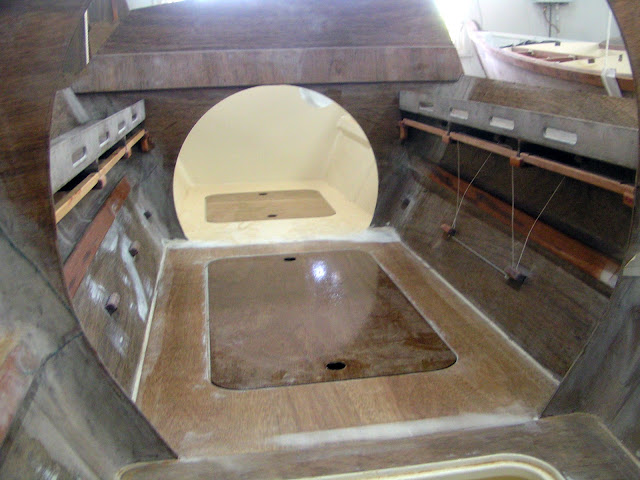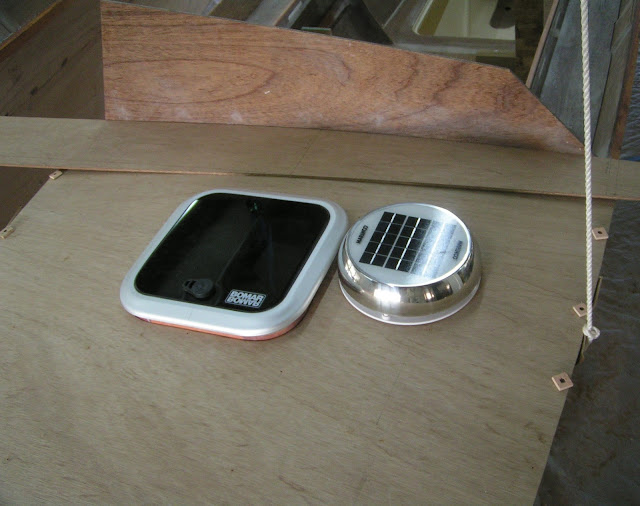A previous episode, Two Years In, discussed the above lashing pads through bolted to the sheer stringers. The 16 lashing pads are closer to their finished state with rounded over corners/edges and epoxy filled through bolt holes. In the foreground are the three drilling templates used to create the sheer stringer holes and now the matching lashing pad holes.
Each template has a fence screwed to one side, thereby precisely locating the holes relative to one lashing pad edge. Lashing pad and template witness marks are aligned to position the pad correctly along the template fence. A screw secures the pad to the template to assure accurate drilling and to later reattach the pads for final drilling. Each hole is drilled three times, first to accurately locate the hole, then to enlarge the hole and finally drilling out the epoxy filling to 1/4" diameter.
16 lashing pads, each with three holes drilled three times is drilling 144 holes. Fortunately, 96 holes can be knocked out quickly with the templates and leave 48 oversized holes remaining. With this many holes it is worthwhile to build a simple drilling aid. A fence screwed to a plywood scrap then clamped to a drill press table sped up the drilling operations. The fence was positioned to drill either the lashing pad top single hole or the lower two holes. Lashing pad witness marks are aligned with those established along the fence. Bing bang boom, a pile of holes is reduced to sawdust. If done over more craftily; each hole would be drilled only twice.
The two electrical panels are taking shape underneath the typical shelving. The solar charge controllers are behind the left panel. A battery monitor is mounted on the left panel face at navel level. It would be difficult to read at that level so it is mounted on an inch and one half protrusion that angles the face up. I have to say this tricky mounting didn't look right the first go round. The plywood had been cut out and the mounting was too high up to look comfortable with the right panel components. In the end it was lowered to provide a reasonably pleasing result.
Below the panel ends to the left and the right are wooden enclosures providing passages for wiring to the electrical components. The left side will carry leads from the battery and the forward starboard solar panel. The right side will carry the port and aft solar panel leads as well as the switched/fused circuit wiring to the remainder of the boat. The wooden enclosures are certainly a cleaner installation than the plastic conduit used in the galley outlet.
The right panel contains the battery disconnect switch and the fused switch panel. The switch panel controls and protects the circuits through out the boat. I'm awaiting the next monthly shipment for wire terminals, wire markers and an additional switch to wire, epoxy coat, install and paint this compartment. Lately some progress has been limited by needed materials arriving in monthly shipments. There is always something else that needs doing, but it's not wise to leave too much hanging. Fortunately, the last shipment provided materials for stuff long hanging:
Grey non-skid is applied to the head floor and newly epoxied in step. This KiwiGrip non-skid is easy to use, it is applied with a special texture roller and cleans up with water. I'm considering this off white color scheme with the KiwiGrip grey for the decks. I think this would be easy on the eyes in the harsh tropical sun.
Here we peer down into the cavernous forward locker. The white paint ran out and it received only one patchy coat months ago. A fresh can of paint and another coat takes it off the list of things long hanging.
Primer paint has not been available for a while and the deck undersides could not be painted until the mana shipment. A different brand of primer was used that only required one coat of primer as opposed to two. This reduced the between coat sands from 3 to 2. Any reduction to sanding is a great boon in boat building.
The painted deck face above sits above the forward bunk compartment. Painting is very time consuming requiring three to four coats with sanding in between. Paint is only applied to the undersides above the bunks to reduce the required labor. The deck undersides are otherwise protected by two epoxy coats. The lime green masking tape is a preparation for installation.
The forward bunk compartment is masked off for deck installation. Areas adjacent to the tape are slathered with epoxy then the deck is installed with screws, squeezing epoxy out onto the tape. A tapered stick scrapes away and collects the excess epoxy. The tape is then pulled away to leave a painted surface free of epoxy smears and blemishes, if all goes well. The most frustrating part was trying to rid epoxy covered gloves of the just removed wadded up masking tape.
As some may have come to correctly suspect this is the much ballyhooed Sudden Assembly Event. Most of the efforts above were in preparation for installing all the decks and the forward locker combings. These parts have been occupying space and gathering long hanging dust for months on end.
Gathering dust has also been a problem in the compartments covered by a deck. It will never be easier to clean these compartments than before the decks are installed and efforts were so directed. All openings to the decked areas are now covered in plastic in what may be a futile effort to keep the compartments dust free.
Earlier I thought installing the decks would reduce the shop chaos. Getting to this point required a variety of processes and materials so that working space could not be found on the 29 foot long workbench. A chaos eradication effort has cleared the bench with other such efforts to come.
The decks are not yet fully installed. At this point the decks are just epoxied to the edge of the 1/4 inch hull panel. A wedge shaped gap, as much as one inch deep, exists between the deck and the sheer stringer below.
Above, the hull is rotated on its' side so the wedge shaped gap is in a better working position. The deck has been flush trimmed to the stringer below. Thicken epoxy is loaded into a baggy with a corner cut off. Squeezing the baggy fills the gap with epoxy and securely bonds the hull and deck.
Robot Army
In a former younger life, in a country far away I enjoyed a robotic lawn mower and a robotic vacuum cleaner. These were cruder times of basicly bump and turn random navigation robots. I enjoyed watching these machines go about their tasks while satisfied with the work completed. In time the vacuum cleaner was revived once and later expired. I suspect the lawn mower may have fared better.
Generally the windows are left open here in Belize. I find that, in spite of living near water, the house is dustier than I knew living all the years in the Washington desert. No one in my single person household takes the time to take care of the floors. The solution to this dilemma arrived with the last mana shipment, I suppose as an early Christmas for me.
The image above shows the beginnings of a robot army. One is to vacuum and the other is to mop. The vacuum is an iRobot S9+ with the super deluxe feature of a base station that sucks the robot's dustbin clean. The first time the vacuum ran the robot returned to base station to empty the bin. An error stopped this operation. The robot's bin exit port was clogged with great wads of hair! A person would think this was a house of nine cats, but it is only me; the still greatly follicled one. This was a one time issue.
iRobot has evolved from the earlier bump/random path approach into systematic navigation. These robots make overlapping straight line passes with alternate behaviors to deal with chair legs, etc. The passes are made systematically starting at the base station mid house and working to the east then the east end adjoining rooms then moving to mid house and working west then the west adjoining rooms. It is interesting to me seeing these robots accurately navigate through a room's door way then abruptly turn to start new cleaning passes.
I've been withholding the sad tale of the iRobot Braava jet m6. This machine does a terrific mopping job. The mopping fluid is contained in a removable tank. The fluid is sprayed ahead of the robot and the robot moves ahead and partly back three times as it progresses mopping across the floor. It then backs up to spray again and repeating the mopping sequence.
The first time I installed the tank with mopping fluid it went in hard and didn't feel right. I got two good mopping runs out of it and thought I would put some citric cleaner in the tank to ward off insects. It seems to go OK the first time, but later I noticed it wasn't always spraying, the tank was leaking and the tank lid would not stay closed. The tank was very difficult to remove from the robot. The tank was broken and distorted. It is hard to believe the spray pump suction could be so strong to damage the tank this way, but no other explanation occurs to me. Replacement tanks are only found from vendors in Thailand and the U.K. in initial searches. The lesson is sure to be not to blow off the instructions stating to use only their mopping fluids.
Random News
Three years in Belize and I've become a cold weather wimp. If the coconut oil is frozen, it is too cold to take a shower. If it is less than 70° F and a breeze is blowing through the house I seek to close windows, put on long pants and possibly a coat. Please friends from the North write and say how you've shed tears for me during a snow shovel workout.
Poking around inside the electric scooter, by a stroke of luck, seems to correct the cogging issue previously mentioned. The scooter was back on the road briefly before developing a new issue. The rear brake caliper had seized reducing range, top speed and not to mention damaging the brake. In time it was discovered a caliper piston had somehow received a nick that prevented it from retracting. A little work with a file and fine sandpaper makes the scooter good to go whenever the weather is accomodating.



























































